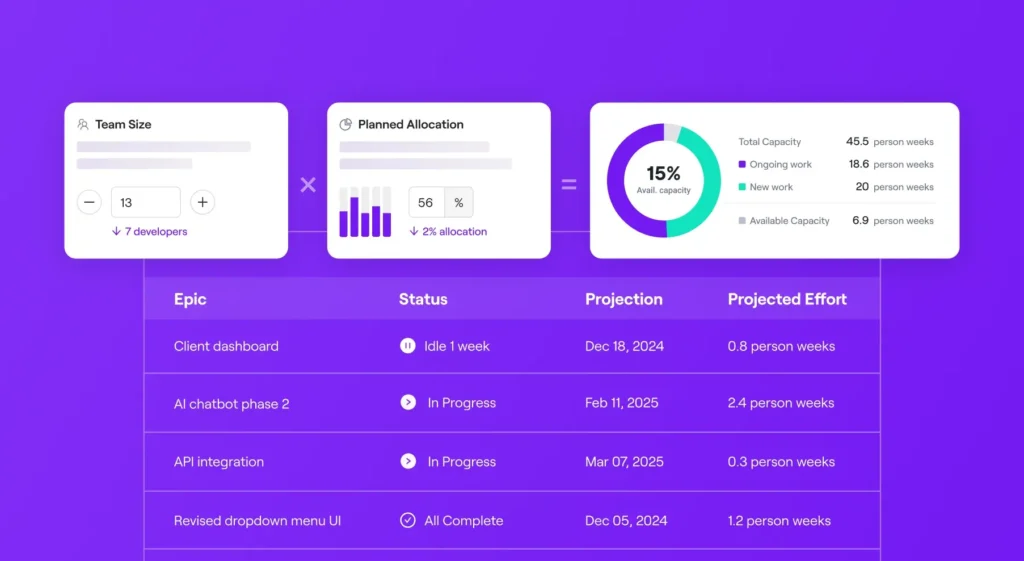When an engineering organization is growing quickly, how can they make sure they’re staying on track and moving in the right direction? In a recent webinar, Fatima Katafer (Agile Delivery Lead) and Baptiste Bouchet (Scrum Master) from ManoMano spoke with Jellyfish Product Marketing Director Adam Harris about their experience using Jellyfish to inform objectives and key results (OKRs).
This post will explain why OKRs are so important for guiding engineering work and achieving strategic goals, while sharing examples from ManoMano’s experience implementing an OKR framework. To listen to the full discussion, check out the recording.
What are OKRs and why do they matter?
OKRs are a goal-setting framework that provide teams with a clear picture of what needs to be accomplished in relation to the overall strategy. OKRs provide a clear roadmap for progress, enabling greater agility at both a team- and company-wide level.
OKRs bring together two components: overarching objectives and smaller key results that feed into those objectives.
- Objectives: Creating a good objective begins with understanding the company’s vision. What are the one-year, three-year, and five-year plans for the organization? That vision should help leaders to identify high-level goals and then establish high-level objectives that align with those goals. Objectives should be brief, but they should also provide enough context to convey both the why and the how around fulfilling them. Objectives should strike a useful balance between inspirational and operational, and they should answer two questions: what is the desired outcome, and how does this impact the organization?
- Key results: Key results provide the means to track objectives. A good key result will be narrow and specific; engineering leaders should avoid the temptation to conflate key results with objectives. Key results should serve as a measure of the success or failure of the objective, and they should provide context on what occurred and in which channels. Key results can always be redeveloped if they prove ineffective.
How ManoMano established their OKR framework
ManoMano is an online marketplace offering DIY, home improvement, and gardening products. The marketplace operates in Belgium, France, Germany, Italy, Spain, and the UK.
For ManoMano, a period of rapid acceleration caused them to implement a new approach to strategic goals and OKRs. The company needed to align more than 500 employees and ensure they were all working towards the same objectives. At the same time, the organization was implementing ambitious new projects with increased complexity for management. All of this added up to a forcing function for ManoMano to take a more systematic approach to goals and objectives.
The result was a new OKR structure, which they combined with their engineering management platform (EMP) to achieve strategic goals.
Using Jellyfish for effective goal setting
EMPs like Jellyfish provide rich insights into how, where, and when teams are operating. Here are a few examples of how EMPs can inform goal setting and OKRs.
Measuring combined effort with allocations
Allocation metrics allow engineering leaders to see how combined effort is being divided among teams. Full-time employees (FTEs) serve as the unit of measurement for allocations. FTEs track how much effort was spent on a specific project or task, whether that’s wide (campaigns, initiatives, etc.) or narrow (new features, bug fixes, etc.).
Allocation data can be used to provide context and nuance for key results, which can in turn indicate progression towards the overall objective. ManoMano realized significant value by leaning heavily on allocations measurements, conducting frequent check-ins on OKRs at the team level. The team evaluates where they are in relation to completing their objectives and what the allocation data is indicating about key results. Each check-in offers an opportunity to realign efforts, incorporate new tasks into sprints, or open/close specific OKRs.
Enabling feedback loops
Feedback loops are a vital tool for strategic goal setting: OKRs shouldn’t be rigid. By enabling feedback loops, engineering leaders can take action to make OKRs as useful as possible and ensure every employee’s voice can be heard. For ManoMano, feedback loops are implemented in regular OKR syncs that include executives across different departments. During these meetings, the attendees answer the following questions around OKRs:
- Are the OKRs still relevant?
- How will individuals and teams be affected by changes to priorities?
- If efforts are focused on specific areas, should they be prioritized or deprioritized?
These OKR syncs allow engineering leaders to bridge gaps between teams’ workflows and dependencies, while also identifying and eliminating less useful OKRs. ManoMano has a strong culture of change and agility, and this feedback loop allows the organization to take on a wider range of tasks in a shorter period of time.
ManoMano also encourages feedback loops at lower levels. Team-level check-ins allow for a democratic process of strategic alignment: team leaders present the company’s vision to the individual engineers, who are then encouraged to discover ways to contribute to the vision. While every employee’s input might not result directly in actual changes, each idea is passed along to upper levels of management. This feedback loop helps to align aspirational and operational objectives at every level of the company.
Aligning engineering work and improving delivery management
Since implementing their OKR framework, ManoMano has significantly improved strategic alignment and delivery. Effective goal setting and OKRs lead to increased business alignment across the entire organization, ensuring everyone is working to realize the company’s strategic vision.
To watch the rest of the ManoMano Deep Dive webinar, Aligning Engineering Delivery with Strategic Goals & OKRs, click here.
For more insights on delivery management, check out this recent blog post from Jellyfish Head of Customer Strategy Ryan Kuchova.







